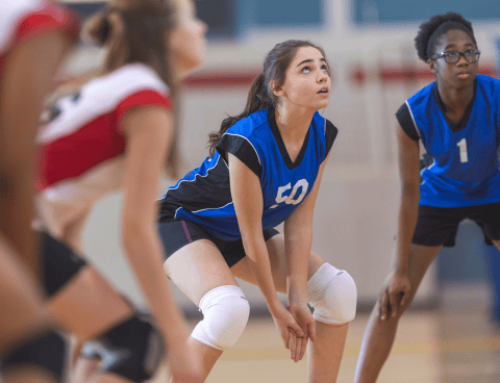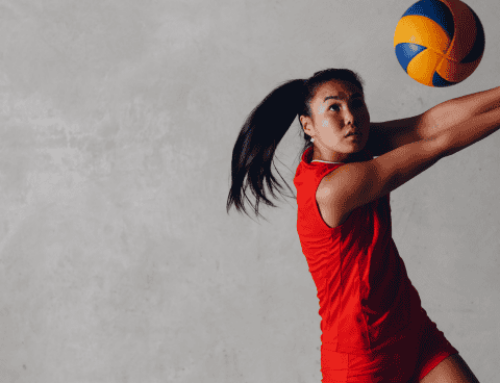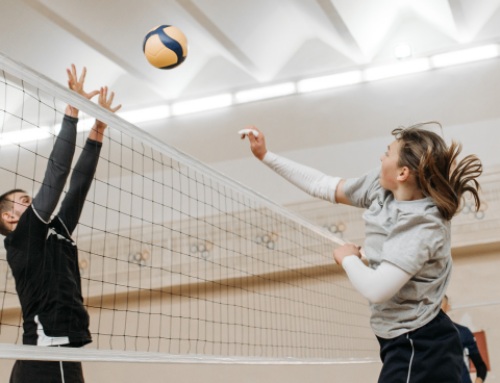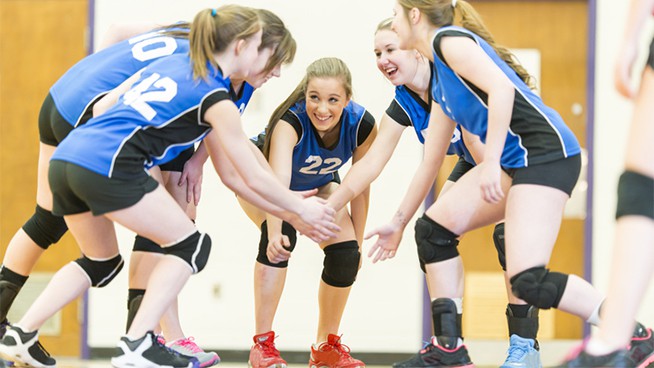All The Volleyball Positions Explained
Volleyball is exciting, though sometimes confusing, sport to watch. With players subbing in and out and the ball flying everywhere, it may seem like total chaos. But at the very least, it’s organized chaos, and it’s even poetry in motion at times.
In volleyball, there are twelve players on the court at one time. A net divides the court and six athletes from each teamwork to keep a ball in motion and try to score points by making the ball hit the floor on the opposing team’s side. A server, who serves the ball over the net, starts the play, and then using hits, blocks, and digs, players keep the ball moving and work to score the point.
After winning a point, players shift positions in a clockwise rotation. Front row players are allowed to break or reach over, the plane of the top of the net and therefore can attack and block. Back row players focus on defense but can attack the ball if they leave the ground 10 feet back from the net.
Though all players must be skilled at the basic volleyball skills, passing (bumping), volleying, digging, setting, hitting (spiking), and serving, each position has specific responsibilities and skills that need to be fine-tuned. The six main positions are outside hitter, opposite hitter, middle blocker/hitters one setter, Libero, and defensive specialist some teams, especially at higher levels, have a seventh position, the serving specialist. Take a closer look at all seven positions.
Setter
The setter is like the quarterback on a football team or the basketball team’s point guard; they direct play on the court. Their main responsibility is to get the second hit (touch) and set up their hitters for an attack. The setter often plays around the rotation, so they are also responsible for blocking and playing defensive at times. A setter needs to make quick decisions and have excellent communication skills to get the job done.
Responsibilities:
- Leader on the court
- Run the offense
- Set the ball for attacks
- Use dump shots
- Block and dig on defense
- Identify blockers
Outside Hitter
The outside hitter, also known as the left-side hitter, attacks from the left side of the net near the antenna. On many teams, they are the primary hitter. When playing on the front row the outside hitter works with the middle hitter in blocking the opposing attacks. When rotated to the back row they are responsible for passing and defense. Outside hitters can jump high, are quick on their feet, and are ready to adapt to any situation.
Responsibilities:
- Main hitter on offense
- Block on defense
- Play front and back row
- Primary passer
- Read opponents defense and call hitters
Opposite Hitter
The opposite hitter, also known as the right-side hitter, plays on the right side of the net near the antenna. This hitter is often the most versatile and can play on both offense and defense. They have the ability to jump high and need to be able to hit from the front and back rows. They may also need to set when their setter cannot get to the ball. They often line up against the opponent’s strongest hitter, the outside hitter, and work together with the middle blocker to block.
Responsibilities:
- Hit when receiving the ball
- Block on defense
- Work with middle blocker
- Dig on attacks and defense
Middle Blocker / Hitter
This position is known as either the middle blocker or middle hitter. It is often the team’s tallest athlete and best blocker as it is the first line of defense against the opposing team’s hits. The middle blocker blocks the center area of the net and has to be ready for the opponent’s quick middle attacks. They also need to move to either side to help their teammate to block attacks. The middle hitter reads the setter, executes fast attacks and can also help confuse opponents by acting as a decoy.
Responsibilities:
- Block opponent’s shots.
- Use quick attacks on offense.
- Act as a decoy on offense.
Libero
If you’re not familiar with volleyball, the libero can be a very confusing position. A libero is a player who stays in the back row throughout the entire match to play defense and can come in and out of the game as needed without counting against a team’s substitutions. You can tell the libero apart from the other players on the team because they wear a different colored jersey.
The libero often receives the attack or serve and it is their job to turn the first touch into a solid pass to the setter. They may also need to set the ball from the back row if the setter isn’t available. The libero is not allowed to block, set an attack from the frontcourt, or attack the ball above the height of the net.
The liberos number one job is ball control. They are often the player with the quickest reaction time and best passing skills. Their primary goal on offense is to make sure that there is a controlled ball to work with to maximize their team’s chances of hitting or returning the ball. On defense, they must work to keep the ball alive and give their team a chance to win the point.
Responsibilities:
- Control the ball on offense
- Replace certain players in the back row.
- Be ready to dig an opponent’s attack.
- Receive the opponent’s serve.
- Set the ball if the setter isn’t available.
- Keep the play alive
Defensive Specialist
A defensive specialist plays in the back row and is responsible for playing defense and receiving serve. They come into the game to replace players across the back row that may not be as skilled at defense. Unlike the libero, defensive specialists must make a substitution with the referees. Since teams may only have a certain number of substitutions depending on their league rules, defensive specialists are limited to certain situations. However, they can play any spot on the court and can stay in and play the front row if needed.
Responsibilities:
- Replace players in the back row.
- Be ready to dig.
- Play in the front row if needed.
- Play as a back-row hitter.
Serving Specialist
A serving specialist’s job is to sub into a game and serve. These players have consistent serves that are hard to return. After serving they play defense in the back row for the rest of the play.
Responsibilities:
- Strong, consistent serve
- Defense
RECOMMENDED FOR YOU
MOST POPULAR
All The Volleyball Positions Explained
Volleyball is exciting, though sometimes confusing, sport to watch. With players subbing in and out and the ball flying everywhere, it may seem like total chaos. But at the very least, it’s organized chaos, and it’s even poetry in motion at times.
In volleyball, there are twelve players on the court at one time. A net divides the court and six athletes from each teamwork to keep a ball in motion and try to score points by making the ball hit the floor on the opposing team’s side. A server, who serves the ball over the net, starts the play, and then using hits, blocks, and digs, players keep the ball moving and work to score the point.
After winning a point, players shift positions in a clockwise rotation. Front row players are allowed to break or reach over, the plane of the top of the net and therefore can attack and block. Back row players focus on defense but can attack the ball if they leave the ground 10 feet back from the net.
Though all players must be skilled at the basic volleyball skills, passing (bumping), volleying, digging, setting, hitting (spiking), and serving, each position has specific responsibilities and skills that need to be fine-tuned. The six main positions are outside hitter, opposite hitter, middle blocker/hitters one setter, Libero, and defensive specialist some teams, especially at higher levels, have a seventh position, the serving specialist. Take a closer look at all seven positions.
Setter
The setter is like the quarterback on a football team or the basketball team’s point guard; they direct play on the court. Their main responsibility is to get the second hit (touch) and set up their hitters for an attack. The setter often plays around the rotation, so they are also responsible for blocking and playing defensive at times. A setter needs to make quick decisions and have excellent communication skills to get the job done.
Responsibilities:
- Leader on the court
- Run the offense
- Set the ball for attacks
- Use dump shots
- Block and dig on defense
- Identify blockers
Outside Hitter
The outside hitter, also known as the left-side hitter, attacks from the left side of the net near the antenna. On many teams, they are the primary hitter. When playing on the front row the outside hitter works with the middle hitter in blocking the opposing attacks. When rotated to the back row they are responsible for passing and defense. Outside hitters can jump high, are quick on their feet, and are ready to adapt to any situation.
Responsibilities:
- Main hitter on offense
- Block on defense
- Play front and back row
- Primary passer
- Read opponents defense and call hitters
Opposite Hitter
The opposite hitter, also known as the right-side hitter, plays on the right side of the net near the antenna. This hitter is often the most versatile and can play on both offense and defense. They have the ability to jump high and need to be able to hit from the front and back rows. They may also need to set when their setter cannot get to the ball. They often line up against the opponent’s strongest hitter, the outside hitter, and work together with the middle blocker to block.
Responsibilities:
- Hit when receiving the ball
- Block on defense
- Work with middle blocker
- Dig on attacks and defense
Middle Blocker / Hitter
This position is known as either the middle blocker or middle hitter. It is often the team’s tallest athlete and best blocker as it is the first line of defense against the opposing team’s hits. The middle blocker blocks the center area of the net and has to be ready for the opponent’s quick middle attacks. They also need to move to either side to help their teammate to block attacks. The middle hitter reads the setter, executes fast attacks and can also help confuse opponents by acting as a decoy.
Responsibilities:
- Block opponent’s shots.
- Use quick attacks on offense.
- Act as a decoy on offense.
Libero
If you’re not familiar with volleyball, the libero can be a very confusing position. A libero is a player who stays in the back row throughout the entire match to play defense and can come in and out of the game as needed without counting against a team’s substitutions. You can tell the libero apart from the other players on the team because they wear a different colored jersey.
The libero often receives the attack or serve and it is their job to turn the first touch into a solid pass to the setter. They may also need to set the ball from the back row if the setter isn’t available. The libero is not allowed to block, set an attack from the frontcourt, or attack the ball above the height of the net.
The liberos number one job is ball control. They are often the player with the quickest reaction time and best passing skills. Their primary goal on offense is to make sure that there is a controlled ball to work with to maximize their team’s chances of hitting or returning the ball. On defense, they must work to keep the ball alive and give their team a chance to win the point.
Responsibilities:
- Control the ball on offense
- Replace certain players in the back row.
- Be ready to dig an opponent’s attack.
- Receive the opponent’s serve.
- Set the ball if the setter isn’t available.
- Keep the play alive
Defensive Specialist
A defensive specialist plays in the back row and is responsible for playing defense and receiving serve. They come into the game to replace players across the back row that may not be as skilled at defense. Unlike the libero, defensive specialists must make a substitution with the referees. Since teams may only have a certain number of substitutions depending on their league rules, defensive specialists are limited to certain situations. However, they can play any spot on the court and can stay in and play the front row if needed.
Responsibilities:
- Replace players in the back row.
- Be ready to dig.
- Play in the front row if needed.
- Play as a back-row hitter.
Serving Specialist
A serving specialist’s job is to sub into a game and serve. These players have consistent serves that are hard to return. After serving they play defense in the back row for the rest of the play.
Responsibilities:
- Strong, consistent serve
- Defense











